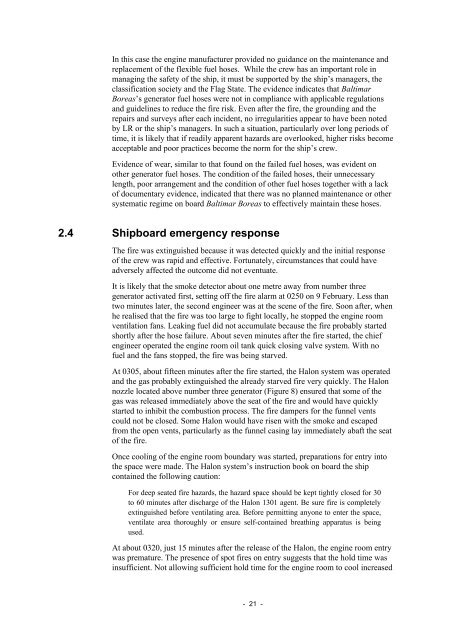Marine Report 236, Independent investigation into the engine room ...
Marine Report 236, Independent investigation into the engine room ...
Marine Report 236, Independent investigation into the engine room ...
Create successful ePaper yourself
Turn your PDF publications into a flip-book with our unique Google optimized e-Paper software.
In this case <strong>the</strong> <strong>engine</strong> manufacturer provided no guidance on <strong>the</strong> maintenance and<br />
replacement of <strong>the</strong> flexible fuel hoses. While <strong>the</strong> crew has an important role in<br />
managing <strong>the</strong> safety of <strong>the</strong> ship, it must be supported by <strong>the</strong> ship’s managers, <strong>the</strong><br />
classification society and <strong>the</strong> Flag State. The evidence indicates that Baltimar<br />
Boreas’s generator fuel hoses were not in compliance with applicable regulations<br />
and guidelines to reduce <strong>the</strong> fire risk. Even after <strong>the</strong> fire, <strong>the</strong> grounding and <strong>the</strong><br />
repairs and surveys after each incident, no irregularities appear to have been noted<br />
by LR or <strong>the</strong> ship’s managers. In such a situation, particularly over long periods of<br />
time, it is likely that if readily apparent hazards are overlooked, higher risks become<br />
acceptable and poor practices become <strong>the</strong> norm for <strong>the</strong> ship’s crew.<br />
Evidence of wear, similar to that found on <strong>the</strong> failed fuel hoses, was evident on<br />
o<strong>the</strong>r generator fuel hoses. The condition of <strong>the</strong> failed hoses, <strong>the</strong>ir unnecessary<br />
length, poor arrangement and <strong>the</strong> condition of o<strong>the</strong>r fuel hoses toge<strong>the</strong>r with a lack<br />
of documentary evidence, indicated that <strong>the</strong>re was no planned maintenance or o<strong>the</strong>r<br />
systematic regime on board Baltimar Boreas to effectively maintain <strong>the</strong>se hoses.<br />
2.4 Shipboard emergency response<br />
The fire was extinguished because it was detected quickly and <strong>the</strong> initial response<br />
of <strong>the</strong> crew was rapid and effective. Fortunately, circumstances that could have<br />
adversely affected <strong>the</strong> outcome did not eventuate.<br />
It is likely that <strong>the</strong> smoke detector about one metre away from number three<br />
generator activated first, setting off <strong>the</strong> fire alarm at 0250 on 9 February. Less than<br />
two minutes later, <strong>the</strong> second <strong>engine</strong>er was at <strong>the</strong> scene of <strong>the</strong> fire. Soon after, when<br />
he realised that <strong>the</strong> fire was too large to fight locally, he stopped <strong>the</strong> <strong>engine</strong> <strong>room</strong><br />
ventilation fans. Leaking fuel did not accumulate because <strong>the</strong> fire probably started<br />
shortly after <strong>the</strong> hose failure. About seven minutes after <strong>the</strong> fire started, <strong>the</strong> chief<br />
<strong>engine</strong>er operated <strong>the</strong> <strong>engine</strong> <strong>room</strong> oil tank quick closing valve system. With no<br />
fuel and <strong>the</strong> fans stopped, <strong>the</strong> fire was being starved.<br />
At 0305, about fifteen minutes after <strong>the</strong> fire started, <strong>the</strong> Halon system was operated<br />
and <strong>the</strong> gas probably extinguished <strong>the</strong> already starved fire very quickly. The Halon<br />
nozzle located above number three generator (Figure 8) ensured that some of <strong>the</strong><br />
gas was released immediately above <strong>the</strong> seat of <strong>the</strong> fire and would have quickly<br />
started to inhibit <strong>the</strong> combustion process. The fire dampers for <strong>the</strong> funnel vents<br />
could not be closed. Some Halon would have risen with <strong>the</strong> smoke and escaped<br />
from <strong>the</strong> open vents, particularly as <strong>the</strong> funnel casing lay immediately abaft <strong>the</strong> seat<br />
of <strong>the</strong> fire.<br />
Once cooling of <strong>the</strong> <strong>engine</strong> <strong>room</strong> boundary was started, preparations for entry <strong>into</strong><br />
<strong>the</strong> space were made. The Halon system’s instruction book on board <strong>the</strong> ship<br />
contained <strong>the</strong> following caution:<br />
For deep seated fire hazards, <strong>the</strong> hazard space should be kept tightly closed for 30<br />
to 60 minutes after discharge of <strong>the</strong> Halon 1301 agent. Be sure fire is completely<br />
extinguished before ventilating area. Before permitting anyone to enter <strong>the</strong> space,<br />
ventilate area thoroughly or ensure self-contained breathing apparatus is being<br />
used.<br />
At about 0320, just 15 minutes after <strong>the</strong> release of <strong>the</strong> Halon, <strong>the</strong> <strong>engine</strong> <strong>room</strong> entry<br />
was premature. The presence of spot fires on entry suggests that <strong>the</strong> hold time was<br />
insufficient. Not allowing sufficient hold time for <strong>the</strong> <strong>engine</strong> <strong>room</strong> to cool increased<br />
- 21 -
















